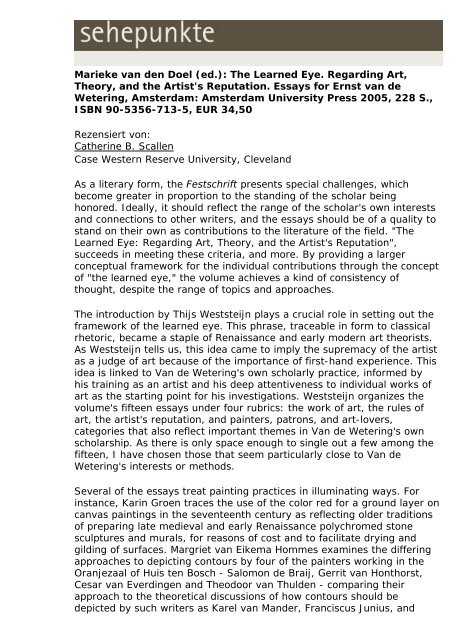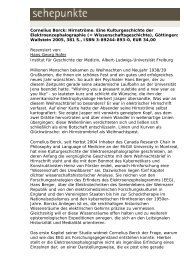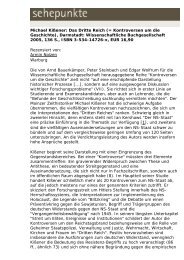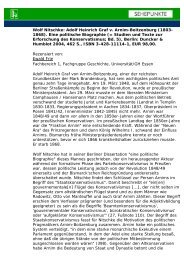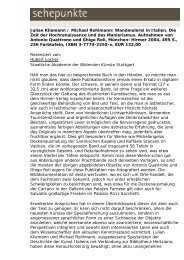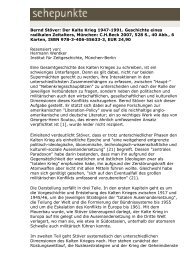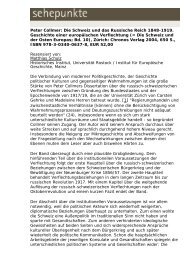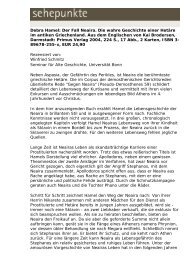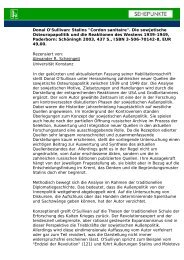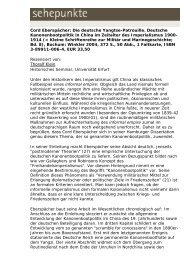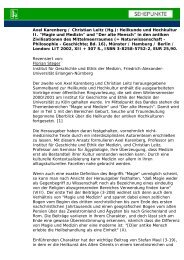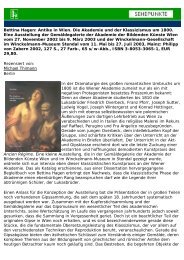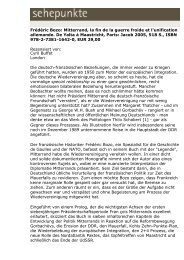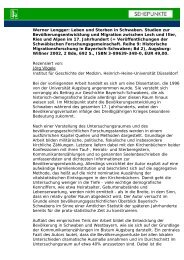Marieke van den Doel (ed.): The Learned Eye ... - Sehepunkte
Marieke van den Doel (ed.): The Learned Eye ... - Sehepunkte
Marieke van den Doel (ed.): The Learned Eye ... - Sehepunkte
Create successful ePaper yourself
Turn your PDF publications into a flip-book with our unique Google optimized e-Paper software.
<strong>Marieke</strong> <strong>van</strong> <strong>den</strong> <strong>Doel</strong> (<strong>ed</strong>.): <strong>The</strong> Learn<strong>ed</strong> <strong>Eye</strong>. Regarding Art,<br />
<strong>The</strong>ory, and the Artist's Reputation. Essays for Ernst <strong>van</strong> de<br />
Wetering, Amsterdam: Amsterdam University Press 2005, 228 S.,<br />
ISBN 90-5356-713-5, EUR 34,50<br />
Rezensiert von:<br />
Catherine B. Scallen<br />
Case Western Reserve University, Cleveland<br />
As a literary form, the Festschrift presents special challenges, which<br />
become greater in proportion to the standing of the scholar being<br />
honor<strong>ed</strong>. Ideally, it should reflect the range of the scholar's own interests<br />
and connections to other writers, and the essays should be of a quality to<br />
stand on their own as contributions to the literature of the field. "<strong>The</strong><br />
Learn<strong>ed</strong> <strong>Eye</strong>: Regarding Art, <strong>The</strong>ory, and the Artist's Reputation",<br />
succe<strong>ed</strong>s in meeting these criteria, and more. By providing a larger<br />
conceptual framework for the individual contributions through the concept<br />
of "the learn<strong>ed</strong> eye," the volume achieves a kind of consistency of<br />
thought, despite the range of topics and approaches.<br />
<strong>The</strong> introduction by Thijs Weststeijn plays a crucial role in setting out the<br />
framework of the learn<strong>ed</strong> eye. This phrase, traceable in form to classical<br />
rhetoric, became a staple of Renaissance and early modern art theorists.<br />
As Weststeijn tells us, this idea came to imply the supremacy of the artist<br />
as a judge of art because of the importance of first-hand experience. This<br />
idea is link<strong>ed</strong> to Van de Wetering's own scholarly practice, inform<strong>ed</strong> by<br />
his training as an artist and his deep attentiveness to individual works of<br />
art as the starting point for his investigations. Weststeijn organizes the<br />
volume's fifteen essays under four rubrics: the work of art, the rules of<br />
art, the artist's reputation, and painters, patrons, and art-lovers,<br />
categories that also reflect important themes in Van de Wetering's own<br />
scholarship. As there is only space enough to single out a few among the<br />
fifteen, I have chosen those that seem particularly close to Van de<br />
Wetering's interests or methods.<br />
Several of the essays treat painting practices in illuminating ways. For<br />
instance, Karin Groen traces the use of the color r<strong>ed</strong> for a ground layer on<br />
canvas paintings in the seventeenth century as reflecting older traditions<br />
of preparing late m<strong>ed</strong>ieval and early Renaissance polychrom<strong>ed</strong> stone<br />
sculptures and murals, for reasons of cost and to facilitate drying and<br />
gilding of surfaces. Margriet <strong>van</strong> Eikema Hommes examines the differing<br />
approaches to depicting contours by four of the painters working in the<br />
Oranjezaal of Huis ten Bosch - Salomon de Braij, Gerrit <strong>van</strong> Honthorst,<br />
Cesar <strong>van</strong> Everdingen and <strong>The</strong>odoor <strong>van</strong> Thul<strong>den</strong> - comparing their<br />
approach to the theoretical discussions of how contours should be<br />
depict<strong>ed</strong> by such writers as Karel <strong>van</strong> Mander, Franciscus Junius, and
Willem Goeree. While each of these painters deviat<strong>ed</strong> to some degree<br />
from the theoretical stance that contours should not be literally<br />
delineat<strong>ed</strong>, they did so in ways that still preserv<strong>ed</strong> the goal of painters<br />
and theorists alike: to enhance the sense of illusionism and convincing<br />
pictorial space. <strong>The</strong> author suggests that Van Thul<strong>den</strong>, who most<br />
consistently us<strong>ed</strong> contour lines, may have continu<strong>ed</strong> the practices of<br />
Rubens and his Antwerp school.<br />
In another close study of artistic practice, Anna Tummers considers<br />
Aelbert Cuyp's application of establish<strong>ed</strong> linear perspectival construction<br />
methods to the creation of his landscapes. <strong>The</strong> author questions the<br />
authenticity of a Cuyp painting in the Frick Collection in New York<br />
(Dordrecht at Sunrise, 1650s) because of inconsistencies in the<br />
application of perspective principles that lead to a more restrict<strong>ed</strong> sense<br />
of depth, contrary to Cuyp's establish<strong>ed</strong> practices.<br />
Arthur Wheelock builds upon Van de Wetering's attention to the technical<br />
use of color in seventeenth-century Dutch art by raising the issue of color<br />
symbolism, a system of meaning well establish<strong>ed</strong> in Netherlandish art of<br />
earlier eras. Though this is an area of symbolic content not yet address<strong>ed</strong><br />
by contemporary scholars of Dutch art, he notes the considerable<br />
attention that Karel <strong>van</strong> Mander and Samuel <strong>van</strong> Hoogstraten gave to<br />
color symbolism in their writings. A list of colors and their symbolic<br />
meanings appears four times in the papers of the Ter Borch studio estate,<br />
leading Wheelock to ponder the "narrative potential" (108) of color<br />
symbolism in two paintings by Gerard ter Borch, and to suggest its<br />
rele<strong>van</strong>ce to a range of artists, including Jan Steen, Johannes Vermeer,<br />
and, in certain cases, Rembrandt <strong>van</strong> Rijn.<br />
Thijs Weststeijn reexamines the seventeenth-century understanding of<br />
Rembrandt's gifts as a history painter when seen through the lens of<br />
rhetorical strategies. Departing from Jan Emmens's positing of a negative<br />
'classicist' critique of Rembrandt, Weststeijn finds in Samuel <strong>van</strong><br />
Hoogstraten a positive, rhetorically-bas<strong>ed</strong> evaluation of Rembrandt as a<br />
master whose work embodi<strong>ed</strong> passio (the passions) and enargeia (or<br />
vivid illustration, emphasizing movement), and "the virtue of<br />
ornatus" (120) or an appropriately ornament<strong>ed</strong> style, in this case<br />
referring primarily to Rembrandt's use of light and color. Van<br />
Hoogstraten's praise of Rembrandt was cast in terms of "the virtues of<br />
the ideal orator," thus providing an alternative model of judgment,<br />
theoretically orient<strong>ed</strong> yet positive in nature.<br />
Eric Jan Sluijter poses the question of why Hendrick Goltzius took up the<br />
art of painting late in his career, in 1600 at age 42. Sluijter indicates that<br />
Karel <strong>van</strong> Mander's statements about how deeply impress<strong>ed</strong> Goltzius was<br />
by painting in Italy, which he saw in 1590-91, provide the most important<br />
clue that this trip arous<strong>ed</strong> a desire to compete with different means than<br />
through his mastery of line express<strong>ed</strong> in drawings and engravings. He<br />
suggests, though, that Goltzius wish<strong>ed</strong> to paint in a Venetian manner<br />
(thus emphasizing the convincing depiction of flesh) and ne<strong>ed</strong><strong>ed</strong> to find
someone who could teach him that. Sluijter offers as candidate for this<br />
instructor Frans Ba<strong>den</strong>s, who had resid<strong>ed</strong> in Italy for four years,<br />
accompanying Jacob Matham (Goltzius's stepson). <strong>The</strong> coinci<strong>den</strong>ce of<br />
timing between Ba<strong>den</strong>s's return to Haarlem in 1597, and Goltzius's<br />
production of technically accomplish<strong>ed</strong> oil paintings in 1600 might thus be<br />
no acci<strong>den</strong>t, and Sluijter reminds us that Van Mander describ<strong>ed</strong> Ba<strong>den</strong>s<br />
"as a painter who play<strong>ed</strong> an important role in the recent changes in the<br />
art of the Netherlands", (162) even if he has fad<strong>ed</strong> into obscurity for<br />
modern audiences.<br />
Michiel Franken discusses the important role of copies in the collection of<br />
the great French art patron Paul Fréart de Chantelou, who commission<strong>ed</strong><br />
a number of copies of Italian paintings through the agency of Poussin.<br />
Ironically, Poussin prov<strong>ed</strong> reluctant to have his own paintings copi<strong>ed</strong> for<br />
Chantelou, and Franken suggests that this was a result of Poussin's desire<br />
to protect the autograph nature of his art, which he produc<strong>ed</strong> without the<br />
assistance of a collaborative workshop.<br />
Finally, the inclusion of a bibliography of Van de Wetering's scholarship is<br />
welcome and will prove useful for many scholars in the years to come.<br />
While every Festschrift contains essays of value, "<strong>The</strong> Learn<strong>ed</strong> <strong>Eye</strong>"<br />
maintains a higher level of general interest than many such volumes. <strong>The</strong><br />
<strong>ed</strong>itors wisely limit<strong>ed</strong> the size of the book, and pick<strong>ed</strong> contributors who<br />
not only had close relationships with Van de Wetering but who could also<br />
look at issues - and specific works of art - anew, with innovative<br />
questions and approaches. <strong>The</strong> volume thus is an appropriate tribute to<br />
Van de Wetering, the central issues of his scholarship, and his<br />
unwavering commitment to works of art as the raison d'être of art history.<br />
R<strong>ed</strong>aktionelle Betreuung: Dagmar Hirschfelder<br />
Empfohlene Zitierweise:<br />
Catherine B. Scallen: Rezension von: <strong>Marieke</strong> <strong>van</strong> <strong>den</strong> <strong>Doel</strong> (<strong>ed</strong>.): <strong>The</strong> Learn<strong>ed</strong> <strong>Eye</strong>.<br />
Regarding Art, <strong>The</strong>ory, and the Artist's Reputation. Essays for Ernst <strong>van</strong> de<br />
Wetering, Amsterdam: Amsterdam University Press 2005, in: sehepunkte 5<br />
(2005), Nr. 12 [15.12.2005], URL: <br />
Bitte setzen Sie beim Zitieren dieser Rezension hinter der URL-Angabe in run<strong>den</strong><br />
Klammern das Datum Ihres letzten Besuchs dieser Online-Adresse ein.<br />
Diese Rezension erscheint auch in KUNSTFORM.


